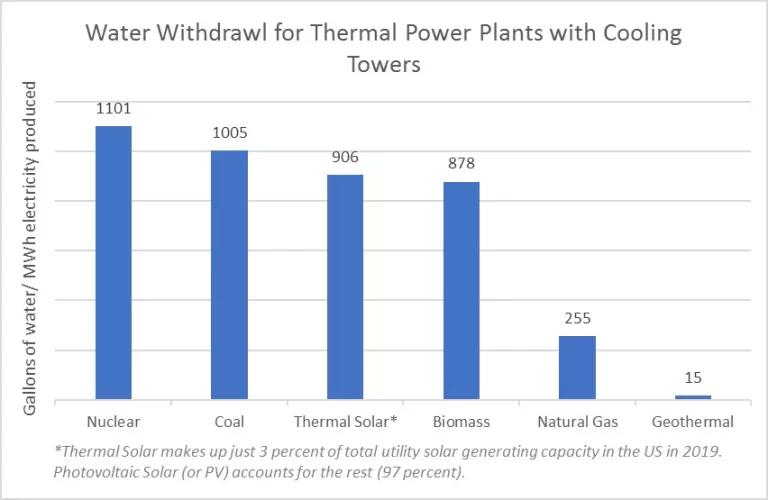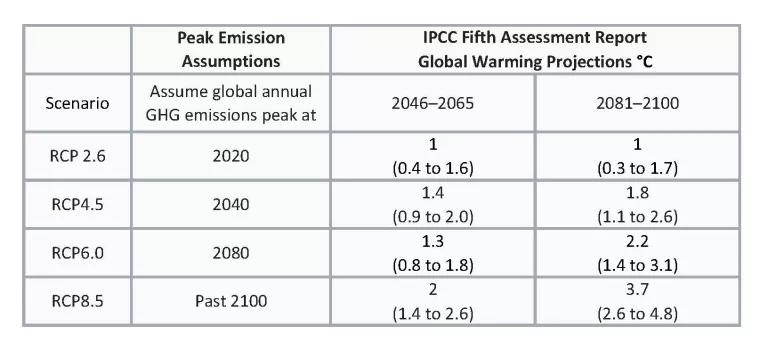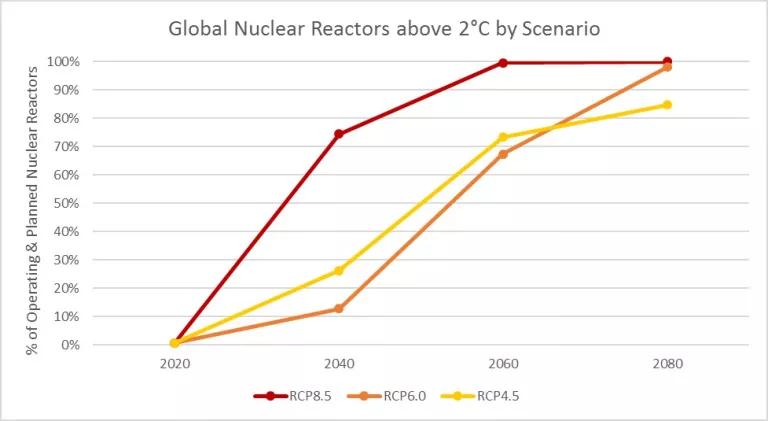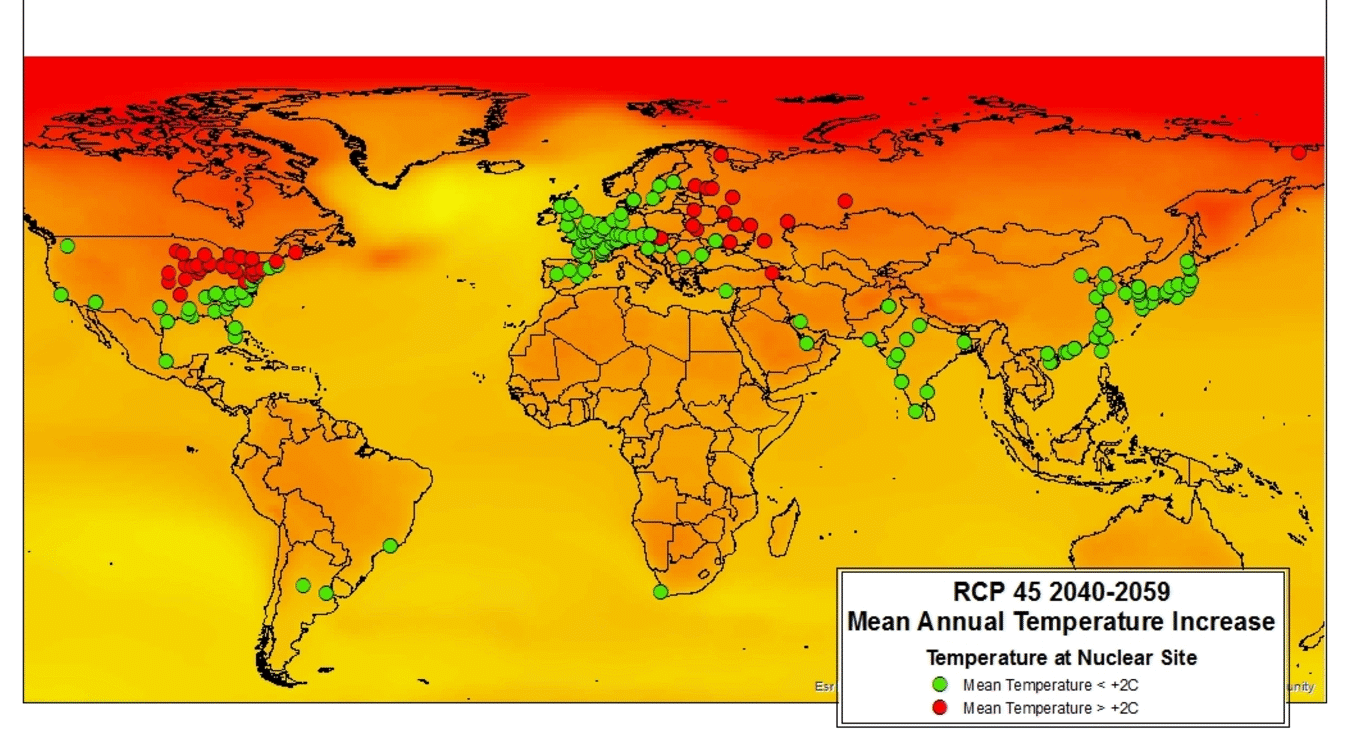Nuclear vs. Climate Change: Feeling the Heat
With increasing temperatures already posing threats to many nuclear plants around the world, we are faced with a sobering picture of nuclear energy’s vulnerability to climate change impacts.

Note: This is part one of a two-part blog series on the impacts of climate change on nuclear power plants. Part one covers the impacts of increasing ambient temperatures, while part two covers the impacts of sea level rise.
This summer’s heatwaves did more than send Parisian swimming in the Trocadero fountains. Unable to cope with high water temperatures and low river flows, six European nuclear reactors were forced to curtail their electricity output and two went offline during a region-wide heatwave late this July. This is not the first (and won’t be the last) time nuclear plants face difficulties operating through extreme heat. In a deadly 2003 summer heat wave in Europe, 30 nuclear units were required to either shut down or reduce their power output.
Nuclear power has been heralded to have the power to “save the world” from the catastrophic impacts of a rapidly changing climate. The problem is, with increasing temperatures already posing threats to many nuclear plants around the world, we are faced with a sobering picture of nuclear energy’s vulnerability to climate change impacts.
What’s the Risk?
Increasing temperatures can result in reduced nuclear reactor efficiency by directly impacting nuclear equipment or warming the plant’s source of cooling water. There is no linear air-water temperature trend given the variability of environmental factors (oxygen content, water levels, industrial activity), nonetheless most rivers in the U.S. show a 0.6-0.8°C increase in water temperature for every 1°C increase in air temperature. This poses a risk for all thermal power plants, not just nuclear units. But, nuclear power is uniquely vulnerable to increasing temperatures because of its reliance on cooling water to ensure operational safety within the core and spent fuel storage.
As the most water-intensive energy generation technology, nuclear reactors are located near a river or the ocean to accommodate hefty water usage, which averages between 1,101 gallons per megawatt of electricity produced to 44,350 gal/MWh depending on the cooling technology. Just as weather varies with location, the degree to which nuclear plants will experience ambient temperature increases will vary. Thus, inland reactors that use rivers as a source for cooling water are the most at risk during heat waves, which according to the Intergovernmental Panel on Climate Change (IPCC) are “very likely” to occur more often and last longer in the coming decades.
Where Are the At-risk Nuclear Plants?
Using climate projection models aggregated from the Environmental Systems Research Institute (ESRI) and the Power Reactor Information System (PRIS) global nuclear power reactor database from the International Atomic Energy Association, we mapped projected temperature increases at each existing and planned nuclear site for several climate change scenarios. Of all four representative concentration pathway (RCPs) scenarios, only RCP2.6 is likely to meet the 2 degrees Celsius goals set by the Paris Climate Agreement.

For us to achieve the trajectory mapped by RCP2.6 and to avoid the catastrophic impacts of a 1.5°C world as mapped by the IPCC’s most recent report, emissions would have to peak next year and plummet to zero by the end of this century. Looking just at observed fossil-fuel emissions, our trajectory is closer to a RCP4.5 scenario, which assumes some mitigation actions. Nonetheless, when including land-use emissions like deforestation, the possibility of a RCP8.5 future, which assumes a “business-as-usual approach,” cannot be discounted.

The graph above shows the percent of operating and planned nuclear power plants that will see annual mean ambient temperature increases of more than 2°C under three RCP scenarios. Under an RCP 4.5 scenario, 26 percent of nuclear power plants worldwide will experience ambient temperature increases of more than 2°C as early as 2040 compared to a 2005 baseline. That’s 131 reactors. Under the same scenario, that number will increase to a whopping 73 percent by 2060.

The nuclear plants that will see the fastest increase in ambient temperature are inland power plants in the U.S. Northeast and Central and Eastern Europe. Under a RCP4.5 scenario, 46 of the 98 operational nuclear reactors in the U.S. (47 percent) will experience ambient temperature increases of more than 2°C by 2040. Under a RCP8.5 business-as-usual scenario, 91 percent of nuclear reactors will have to adapt to mean annual temperature increases of more than 2°C by 2040.

*These values represent the average annual temperature increase for all the nuclear power plants in these regions. They do not represent the average annual temperature increase for the region as a whole.*
Of course, relative gains in temperature are not everything. Plants in warmer climates may face stresses with smaller increases in temperatures and those in cooler climates may be able to adjust to greater spikes in heat. But, as the recent experience in Europe shows, even temperate climates can see extreme heat given the vagaries of global warming.
Within the last decade, multiple nuclear plants across the US have already scaled back generation due to warmer waters brought by heatwaves. Several have requested and obtained permits to increase their maximum temperature limit for their cooling water. This includes Connecticut’s low-lying Millstone plant, which in 2012 was the first nuclear plant to shut down because of rising water temperatures. Unable to prevent a temporary shut-down when its cooling water exceeded 75°F (23.8°C), the Millstone plant requested to increase the minimum temperature to 80°F (26.7°C). Studies have concluded that repeated thermal discharge from nuclear power plants can threaten marine life and the coastal environment. But, while Long Island’s Suffolk County in 2015 voted to commission an independent study on the impact of Millstone’s thermal plume on the aquatic environment in the Long Island Sound, no study has since emerged.
Adaptation Is Necessary
If emissions were stabilized today, temperatures will continue to rise given historic greenhouse gas emissions. As a result, adaption plans must move beyond extending temperature limits after each extreme heat event. The International Atomic Energy Association lists reducing generation and implementing alternative cooling installations (reusing waste water for example) as potential options. This February, the IRSN, a French nuclear safety authority, instructed Electricite de France (EDF), which owns three quarters of nuclear plants in France, to consider hotter and longer heat waves when approving lifetime extensions of reactors.
As nuclear reactors reach the end of their license or if new reactors are sited, it is imperative that climate change projections are not only carefully considered but also accounted for—particularly in the extension of U.S. nuclear plant licenses from 60 to 80 years, a regulatory process called “subsequent relicensing” by the U.S. Nuclear Regulatory Commission. NRDC is currently litigating the adequacy of the environmental analysis of the subsequent license renewal and extension for the Turkey Point Generating Station, a two-unit nuclear plant at the southern tip of Florida, primarily for failure to consider impacts of climate change, specifically the impact of sea-level rise.
While reduced thermal efficiency and electricity output (which raises its own energy security concerns that should not be downplayed) are pressing concerns during scorching heatwaves, rising sea levels coupled with storm surge and increasingly severe weather events can pose even more serious health and safety risks to nuclear plants around the world. If we seek to take advantage of nuclear power’s low carbon attributes, we must carefully assess all risks, including the very crisis that nuclear power aims to help solve—climate change.
For more information about NRDC’s recommendations on Nuclear Energy, see our blog series on our 2017 Pathways Report.


